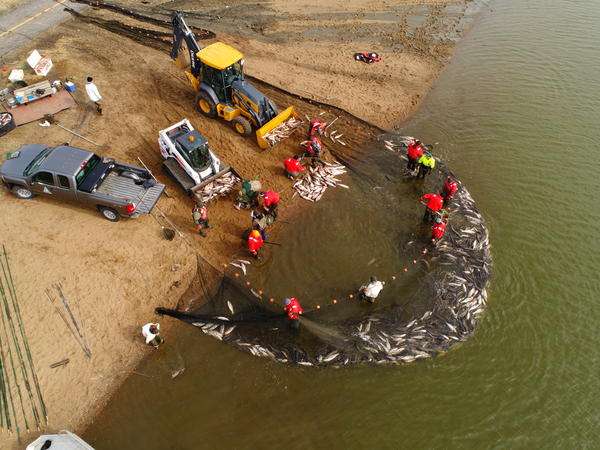
EDDYVILLE, Ky. — Resource managers hope to put a huge dent in Kentucky Lake’s Asian carp population via a harvest technique long employed by — appropriately enough — Chinese commercial fishermen.
Labeled the Unified Method, the strategy involves systematically driving the fish into a confined area and then netting them. Sometime in early to mid February, the Kentucky Department of Fish and Wildlife (KDFW), Corps of Engineers, U.S. Geological Survey (USGS), U.S. Fish and Wildlife Service and other partners intend to try it on one embayment.
If success dictates and time allows, they quickly will follow up with harvest at adjacent Barkley Lake, according to Ron Brooks, KDFW’s former fisheries chief and now aquatic nuisance species program director.
“We’re able to do this thanks to the efforts of Mitch McConnell (Kentucky senator),” Brooks said.
After McConnell heard about the harvest method, which has proven successful in trial runs in Missouri and Illinois, he raised the issue with U.S. Secretary of Interior David Bernhardt and urged the U.S. Fish and Wildlife Service and other federal agencies to get involved.
“The U.S. Fish and Wildlife Service has answered my call to deploy an aggressive strategy to combat these invasive and dangerous species in Lake Barkley and Kentucky Lake,” McConnell said. “With coordination among several agencies at all levels, we can help protect Kentucky’s treasured waters, support our boaters and anglers, and bolster western Kentucky’s $1.2 billion fishing economy.”
In those trial runs, biologists discovered that adding electrical and acoustic stimulation helped drive the fish into confined areas. As a result, 119 tons of carp — an estimated 85 percent of the population — was eradicated from Missouri’s Creve Coeur Lake, a 300-acre oxbow off the Missouri River in early 2018.
“One of the things that get Asian carp really fired up is the sound of outboard motors,” said Missouri biologist Kevin Meneau. “We were able to isolate that sound and broadcast it underwater. We could project that sound and the Asian carp would leave that area, then we could quickly block off those areas they left with giant nets.”
For the Kentucky Lake harvest, three sound boats, three electrofishing boats and three net boats will be used, according to Brooks, who recently watched the strategy implemented near Morrisville, Ill., on the Illinois River.
“We want to do this because of the huge amount of fish that you can harvest in a short amount of time,” he added. “And we want to do this in winter, when the water is colder and fish won’t jump as easily.”
As the carp are driven toward shore by sound and electricity, they will be funneled into channels constructed by placement of block nets. And once trapped, they will be netted or pumped out, employing equipment typically used for commercial salmon harvest. Brooks is hoping for harvest daily during the project that could extend for up to two weeks across more than 200 acres.
Meanwhile, accidental harvest of sport fish should be minimal.
“Sport fish are not as susceptible to sound,” Brooks said. “They typically let sound boats go right over them. That means, as we move the nets closer and closer, we won’t be herding sport fish.”
Additionally, at Creve Coeur, “since native fish tend not to respond to the acoustic stimuli in the same way, the process proved successful in being highly selective to moving only the target fish,” the Missouri Department of Conservation reported.
Brooks estimated that about 20 people will be involved in this carp wrangling, while commercial fishermen possibly wait at the ready with their nets to harvest silvers and bigheads that manage to slip outside the block nets. He also emphasized that fish removed using the modified Unified Method will not negatively impact pricing for carp.
“This will not hurt commercial fishermen,” he said.
Rather, plans still being formulated will allow people to take the fish free if they have the means to transport them to fish meal plants in Illinois and other nearby states. “We’re trying our best to make sure that the fish are not going into a landfill,” Brooks said.
Finally, KDFW and its partners are looking for a few good men and women to volunteer their services. Duties could include assisting on the sound boats, keeping an eye on equipment to prevent vandalism and manning a heated boat at the mouth of the targeted embayment during the night, to warn off boaters.
Those interested should contact Brooks at ron.brooks@ky.gov.
“We want to discourage people who want to come and watch,” he said. “We want to keep motor sounds low and we don’t want confusion.
“We’ll probably have a media event on one of the boat ramps so people can find out what’s going on.”





